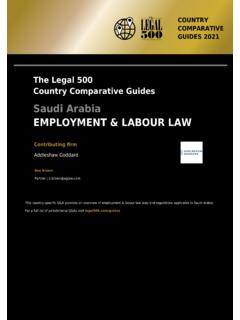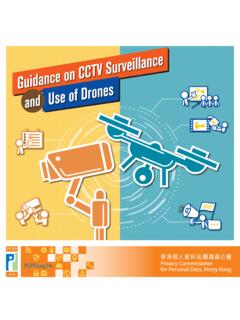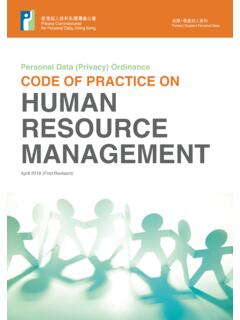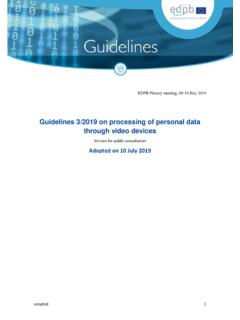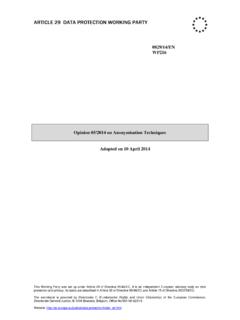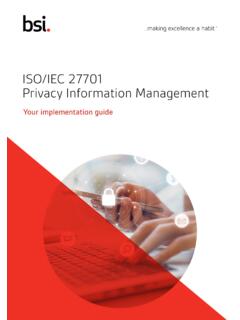Transcription of Guidance on Employee Personal Data - Addleshaw Goddard
1 GDPRG uidance on Employee Personal Data10-10669405-21 IntroductionThe General data Protection Regulation (GDPR), due to come into force on 25 May 2018, will impose significant new burdens onorganisations across Europe including a substantial amount of additional reporting requirements and increased fines and penalties. Itis understood that post-Brexit, the UK will continue to adopt a similar standard for data protection as set out in the GDPR. This guidesets out the key changes under the GDPR and the considerations and actions to take in relation to Employee Personal implement new legislation?
2 The aim of the GDPR is to bring a unified approach to data privacy law in line with modern use of and the international transfer ofpersonal GDPR is not intended to restrict the processing of Personal data , but rather align it to the modern digital world and ensure thatsuch processing is done in a way that protects data subject's rights. For example many organisations outsource services to thirdparties ( payroll or training services), use cloud hosting services (rather than onsite data racks) and engage with data subject ( training/surveys) to collect and analyse workforce demographic, knowledge and expertise.
3 Such behaviour will need to bereviewed (but not necessarily restricted) in light of the upcoming is the scope of the GDPR?Many of the existing core concepts under the data Protection Act 1998 (DPA) which implements the EU data Protection Directive95/46/EC (Directive) are reflected in the GDPR. Familiar concepts of Personal data , data controllers, and data processors are broadlysimilar in both the DPA and the GDPR. HR teams will be well aware of how the broad definition of processing under the DPA capturestheir retrieval, management, transmission, destruction and retention of Employee Personal data and this will be the case under theGDPR as the GDPR Personal datanow includes information relating to a living person, who can be identified directly or indirectly bysuch information ( name, ID number, location data , an online identifier, one or more factors specific to the physical.)
4 Physiological, genetic, mental, economic or social identity of that person). Under the GDPR,sensitive Personal data (which hasa higher threshold of protection) will include genetic data , biometric data and data concerning sexual orientation in addition to theprevious categories such as race/ethnic origin, trade union membership, health and criminal GDPR extends the obligations and territorial reach of current data protection legislation. Going forward, data processorswho process Personal information on behalf of a data controller will have direct statutory obligations.
5 Specific processing termsset out in the GDPR will need to be incorporated in any written agreements between data controllers and data the GDPR will apply to non-EU companies processing EU individual's Personal data for example by selling to, ormonitoring the behaviour of, EU a human resource/employment team perspective, the first step is to understand the flow of Personal data within thebusiness. For international organisations this will require a further understanding as to how such data flows across borderswithin the group.
6 For example where employers outsource a particular function, perhaps data hosting (which includes HR data )and/or management of payroll service, such services will be subject to the more stringent obligations under GDPR. Moreover,non-EU affiliates using shared resources and/or centralised functions are likely to be directly affected by the GDPR given itsfurther territorial scope. Organisations should review their existing contracts in light of GDPR, assessing current policies andprocedures in place in light of the flow of data across the business.
7 Going forward, the increased obligations and liability underGDPR should be considered in future negotiations to ensure an adequate risk allocation with suppliers. In general, businessesshould expect more lengthy and difficult negotiations with suppliers as they try to address their new exposure under consent be relied on?Similar to the DPA, the GDPR also requires the processing of Personal data to be in accordance with certainconditions ofprocessing. One of these conditions, which is often relied on, is the data subject's consent, with wording in privacy noticesand/or employment contracts confirming the Employee 's consent to the processing of their Personal data .
8 The strength of suchconsent is already questionable under the DPA due to the imbalance of the employer and Employee relationship. Furthermore,the consent is often obtained in conjunction with the employment, to get the job, the Employee must sign the employmentcontract and consent to the processing of Personal GDPR introduces a higher burden forconsent- it must be freely given, specific, informed and clearly indicated by astatement or positive action. If consent is given through a written declaration it must be clearly distinguishable from othermatters and easy to obtain specific consent, when processing has multiple purposes and consent is being relied on for each purpose, consentneeds to be obtained each purpose.
9 Additionally, prior to giving consent, the Employee must be informed they have the rightto withdraw consent at any should review the justifications that are relied on for processing Employee data and, where relevant, consider whetherit will still be appropriate to rely on consent. This should be considered in light of that, even if freely given, consent can bewithdrawn. An alternative would be for an employer to rely on the condition that the processing is necessary for legitimateinterests (for example when processing Personal data for administrative purposes).
10 It is not yet clear as to the higher thresholdfor sensitive Personal data ofexplicit consent,however, it is understood that this will also be required to be freely given,specific, informed and is a fair processing notice?Thetransparencyrequirements under the GDPR require companies to provide individuals with extensive information abouthow their Personal data is collected, stored and used. This information must be easily accessible, transparent and presentedusing clear and plain language.

